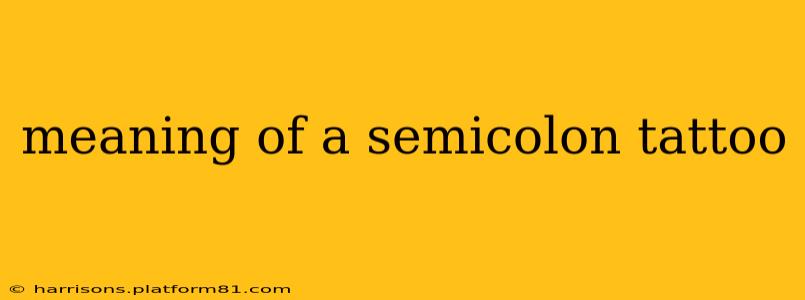The Meaning of a Semicolon Tattoo: A Symbol of Perseverance and Hope
The semicolon tattoo has become a powerful and widely recognized symbol of resilience, hope, and the ongoing fight against mental health struggles. Its simple design belies a profound message of continuation and the choice to keep living. But what exactly does a semicolon tattoo mean, and why has it resonated so deeply with so many?
This article delves into the meaning and significance of semicolon tattoos, exploring its origins, symbolism, and the impact it has had on the mental health community. We'll also address some frequently asked questions surrounding this meaningful ink.
What does a semicolon tattoo symbolize?
At its core, the semicolon tattoo represents the interruption of a sentence that could have ended. In grammar, a semicolon signifies a pause, not an end. It indicates that the writer chose to continue, despite the potential for the sentence (and life) to end there. This powerful metaphor translates perfectly to the lived experience of those struggling with mental health challenges such as depression, anxiety, or suicidal thoughts. The semicolon symbolizes the conscious decision to keep going, to persevere despite overwhelming difficulties.
Where did the semicolon tattoo originate?
The semicolon tattoo's popularity is largely attributed to Project Semicolon, a non-profit organization founded by Amy Bleuel in 2013. Inspired by her own battles with depression, Amy created Project Semicolon to provide support and raise awareness for mental health. The semicolon quickly became the organization's symbol, spreading through social media and inspiring countless individuals to get the tattoo as a symbol of their own struggles and survival.
Why do people get semicolon tattoos?
People get semicolon tattoos for a variety of reasons, all stemming from a shared experience of facing and overcoming mental health challenges. The tattoo serves as:
- A reminder of resilience: It's a visible testament to the strength and perseverance required to navigate difficult times.
- A symbol of hope: The semicolon offers a beacon of hope for the future, a reminder that things can and will get better.
- A mark of solidarity: The tattoo fosters a sense of community and shared experience among those who have struggled with mental health.
- A personal statement: It's a powerful and personal way to express one's journey and triumph over adversity.
- A conversation starter: For some, the tattoo serves as a way to initiate conversations about mental health and reduce stigma.
Is a semicolon tattoo a sign of self-harm or suicide?
No, a semicolon tattoo is not a sign of self-harm or suicide. It's quite the opposite; it's a symbol of choosing to live and overcoming adversity. While the tattoo may be chosen by individuals who have contemplated self-harm or suicide, it ultimately represents their decision to continue living.
What are some other meanings associated with the semicolon tattoo?
While the primary meaning centers around mental health, some people associate the semicolon tattoo with other ideas of perseverance and continuation, including:
- Overcoming addiction: The semicolon can symbolize overcoming addiction and choosing sobriety.
- Surviving trauma: It can represent the strength to move forward after experiencing trauma.
- Celebrating life's challenges: It can serve as a reminder of the challenges overcome and the strength gained through perseverance.
How can I support someone with a semicolon tattoo?
If you see someone with a semicolon tattoo, you can offer your support by acknowledging its significance. A simple acknowledgment or a conversation about mental health can go a long way in reducing stigma and promoting understanding. It’s important to approach the conversation with sensitivity and respect, allowing the individual to share as much or as little as they feel comfortable with.
In conclusion, the semicolon tattoo is more than just ink; it's a powerful statement of hope, resilience, and the ongoing fight for mental well-being. Its widespread adoption demonstrates the importance of open conversations around mental health and the strength found in shared experiences. It serves as a visible reminder that even in the darkest of times, there is always the possibility of continuing, of choosing life, and of finding hope amidst the struggle.
